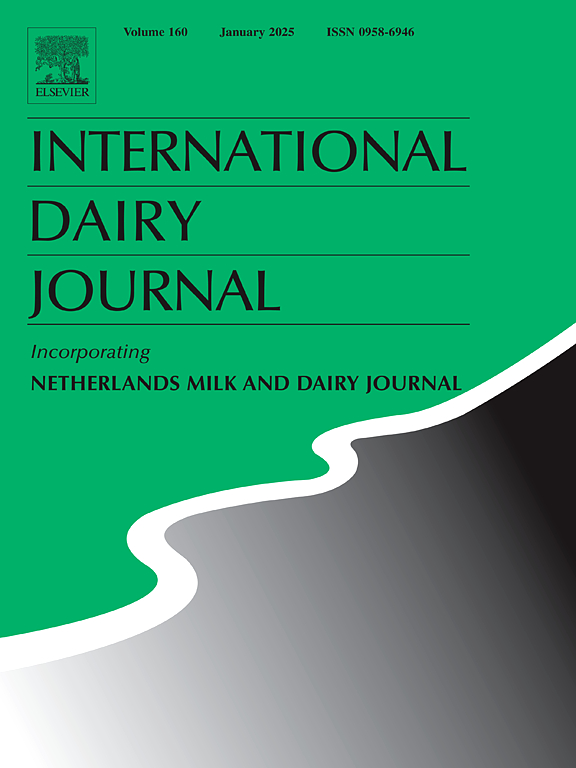脂肪类型和均质化对填充低水分部分脱脂马苏里拉干酪酪蛋白网络中脂肪整合的影响:探讨结构-功能关系
IF 3.4
3区 农林科学
Q2 FOOD SCIENCE & TECHNOLOGY
引用次数: 0
摘要
这项工作考察了含有非乳制品脂肪(棕榈油或葵花籽油)的乳膏在制造填充低水分部分脱脂马苏里拉奶酪中的潜在应用。据此,阐明了结构-功能关系。相对于用非均质牛奶制成的对照奶酪,用脱脂牛奶稳定的棕榈油或葵花籽油制成的奶酪在30或130巴均质,其功能表现出较差的程度,下降的程度主要取决于脂肪的类型,在较小程度上取决于脂肪滴的大小分布。因此,冷冻扫描电镜成像证明了脂肪-蛋白质相互作用是奶酪功能的关键决定因素。用葵花籽油制备填充奶酪,并将均质压力从30 bar提高到130 bar时,脂肪滴与酪蛋白网络的相互作用明显增强。因此,在填充奶酪加热过程中,脂肪类型是影响脂肪滴与酪蛋白相互作用的主要因素,而均质压力的影响相对较小。本文章由计算机程序翻译,如有差异,请以英文原文为准。
Influence of fat type and homogenization on fat integration into the casein network of filled low-moisture part-skim mozzarella: exploring structure-function relationships
This work examines the potential application of creams comprising non-dairy fat (palm oil or sunflower oil) for the manufacture of filled low-moisture part-skim mozzarella. Hereby, the structure-function relationships were elucidated. Relative to control cheeses made from non-homogenized bovine milk, cheeses made from skim milk-stabilized palm oil or sunflower oil creams homogenized at 30 or 130 bar exhibited poorer functionality with the extent of the decline being primarily dependent on the type of fat and to a lesser degree on the size distribution of the fat droplets. Hereby, Cryo-SEM imaging demonstrated the role of fat-protein interactions as a key determinant of cheese functionality. The interaction between fat droplets and the casein network was notably enhanced when sunflower oil was used to prepare filled cheese and when the homogenization pressure was intensified from 30 to 130 bar. The fat type was therefore identified as the main factor influencing the interaction between fat droplets and casein during the heating of filled cheese, whereas homogenization pressure had a comparatively smaller impact.
求助全文
通过发布文献求助,成功后即可免费获取论文全文。
去求助
来源期刊

International Dairy Journal
工程技术-食品科技
CiteScore
6.50
自引率
9.70%
发文量
200
审稿时长
49 days
期刊介绍:
The International Dairy Journal publishes significant advancements in dairy science and technology in the form of research articles and critical reviews that are of relevance to the broader international dairy community. Within this scope, research on the science and technology of milk and dairy products and the nutritional and health aspects of dairy foods are included; the journal pays particular attention to applied research and its interface with the dairy industry.
The journal''s coverage includes the following, where directly applicable to dairy science and technology:
• Chemistry and physico-chemical properties of milk constituents
• Microbiology, food safety, enzymology, biotechnology
• Processing and engineering
• Emulsion science, food structure, and texture
• Raw material quality and effect on relevant products
• Flavour and off-flavour development
• Technological functionality and applications of dairy ingredients
• Sensory and consumer sciences
• Nutrition and substantiation of human health implications of milk components or dairy products
International Dairy Journal does not publish papers related to milk production, animal health and other aspects of on-farm milk production unless there is a clear relationship to dairy technology, human health or final product quality.
 求助内容:
求助内容: 应助结果提醒方式:
应助结果提醒方式:


